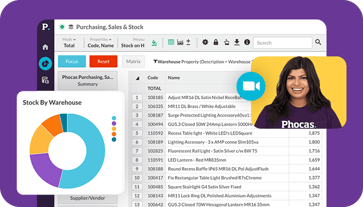Are You Getting the Top Level View of Your Data?
In the current business intelligence market, visual display of data is one of the big-ticket items that customers are seeking. People want eye-catching and easy-to-use graphs, dials and dashboards.
And being a data nerd, at first I found this odd. What can a chart or a dial tell you that the raw data driving that visual can’t? Why not just look at the data and get all of the detail in the first place?
Since then, I’ve realised that what is driving the interest in the visual display of data is the need for a top level view.
Take the below picture, for example:

There’s a lot of detail — right down to individual rocks and dirt. But what’s it a picture of? If we followed the paths in the dirt, we eventually might figure it out…or maybe we’d just see a lot more rocks and dirt.
But if we take a higher view, we get the big picture in a glance.

A well-constructed dashboard with the right metrics can give you that top-level view of your business, enabling you to see at a glance what’s working and what’s not. With the right dashboard, you can just drill down and concentrate on the detail as the problem areas, instead of wading through all of the rocks and dirt trying to figure out what is it you’re seeing!
With Phocas, you have the ability to create an awesome dashboard on anything that you have data for. One particular area this is useful is for customer and vendor scorecards.
A customer scorecard gives you a single place to look when you’re talking with your customers. Imagine, just before you walk in for customer review, you bring up a scorecard that will show you:
- How their overall sales are going this year vs last year,
- What they are buying more of and what they bought less of
- Their payment history and even
- How all of those other metrics compare to others in the same industry.
Now if in the process of the customer review they want more detail about something you raise, it’s an easy click through to the data behind the widget right down to the invoice level. Your customers will be impressed (and maybe a little shocked) at how much you can tell them about them.
The same method of dashboarding can also be used to create a scorecard for your vendor/suppliers. At a glance, you can see;
- What you bought and sold from them,
- What your top moving and slow moving items are from that vendor
- The margin you made on their products and
- Actual average lead time compared to what was promised.
Right there in a single screen and in easy-to-read graphics, you’ll find everything you need to help negotiate your next deal with that vendor.
The best thing of all is that with Phocas, customer and vendor dashboards are not only easy to use, they’re easy to create too.
So the question is—are you getting a top-level view of your key data, and if not, why not?


Craig is an expert in data analytics helping customers determine specific data requirements so they can enhance performance, productivity and confidence.
Related blog posts

Picture a football coach preparing for the big game. He watches game‑tape, studying player metrics, analyzing every play and using real‑time stats to inform strategy. That’s exactly how sales managers and sales leaders should approach their coaching program—with a data‑driven approach.
Read more
Sales professionals operate in face-paced environments with savvy customers who have a lot of choice. Whether you're in B2B sales or working with consumers, the sales process is challenging with longer sales cycles, more decision-makers and higher expectations for follow-up and advice. To stay competitive, sales reps and sales teams need the best sales tools to reduce administrative tasks and improve sales team performance.
Read more
“Free BI tools trial, business analytics software for free, free BI reporting with AI-powered insights”– these offers are tempting business people all the time especially as new open-source players enter the market and want cut-through.
Read more
For many sales professionals, the phrase daily sales report used to conjure up thoughts of frustrating delays and data that's already stale by the time it is received. Often these reports were created by the IT or finance team who had a long list of requests, so the information was more of an historical snapshot. Fortunately, the creation of sophisticated data analytics has improved this work, transforming sales reporting into a self-service and quick task.
Read more
Find out how our platform gives you the visibility you need to get more done.
Get your demo today